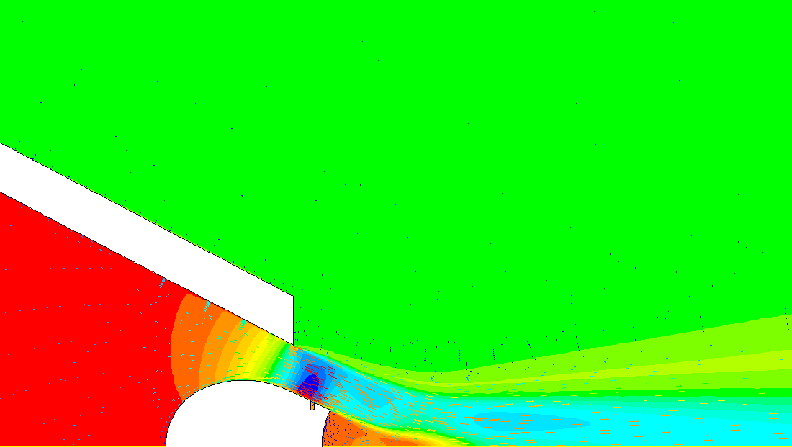Computational and Applied Computational Fluid Mechanics
Spring 2006

Temperature distribution and velocity arrows of the flow in a nozzle
A comprehensive course on theory and practice of computational fluid
dynamics, CFD, in two parts is given jointly by the Department of Numerical
Analysis (NADA) and the Department of Mechanics. Introductory lectures
for students needing more background in fluid mechanics or numerical anlysis
will be given. For a detailed outline download this PDF file.
Homeworks, instructions and other course material related to the part
of the course Katarina Gustavsson, NADA teaches can be found HERE
Homeworks, instructions and other course material related to the part
of the course Dan Henningson, Mekanik teaches can be found HERE,
including course notes.
5C1212, 5 credits, period 3
Presents modern numerical methods for steady and unsteady
compressible and incompressible flow. Space discretization by finite
differences, finite volumes and finite elements will be applied to the
Navier-Stokes equations.
Course Responsible
Dan Henningson,
+46-8-790 9004, henning@mech.kth.se
Katarina Gustavsson,
+46-8-790 6696, katarina@nada.kth.se
5C1213, 2 credits, period 4
Applied computational fluid dynamics with an introduction
to state of the art software for flow simulations and visualizations.
Student projects related to different industrial applications. You
will find information about this course HERE.
Course Responsible
Stefan Wallin, +46-8-5550 4318, wns@foi.se
Course info 5C1212 Computational Fluid Dynamics
Abstract
An in-depth course on numerical methods for computer simulation
of fluid flows. Together with 5C1213 "Applied Computational Fluid Dynamics"
(2 cred.), a comprehensive course on theory and practice of computational
fluid dynamics.
Goals
To give the students
- Familiarity with the partial differential equations for
flow phenomena, and numerical methods for their solution
- Experience in using and developing flow simulation software
for the most important classes of flows in engineering and science
The theory and skills learned will enable students to
- understand properties and limitations of different mathematical
and computational models,
- undertake flow computations using current best practice
for model and method selection, and assessment of the quality of results
obtained
Syllabus
Short introduction with review of either numerical methods or
the basic equations of fluid dynamics (the class will be divided in
two groups). Conservation laws: the Navier-Stokes equations. Different
levels of approximation, the Euler and Reynolds Averaged equations. Turbulence
models. Basics of finite approximations for partial differential equations.
Mathematical properties of hyperbolic systems. Numerical treatment of
shocks. Finite volume and finite element methods. Boundary conditions.
High-resolution methods. Grid generation. Practical algorithms for compressible
and incompressible flow. Computer exercises with methods for the Euler
equations in 1D and different approximations for 2D compressible and incompressible
flows.
Prerequisites
- A course in computer science or programming (e.g. 2D1340,
2D1342);
- Background in either fluid dynamics or numerical methods,
corresponding to one of the second level courses in numerical methods
2D1220-2D1225, 2D1250-2D1260, 2D1266, or a course in fluid dymamics e.g.
5C1203 or equivalent.
Follow-up
5C1213 "Applied Computational Fluid Dynamics" (2 cred.) covers selected
industrial and research topics in student projects with invited specialists.
Examination
A written examination (TEN1; 2 cr.).
Homework and computer assignments (LAB1; 3 cr.).
Course material
Made available in class.

